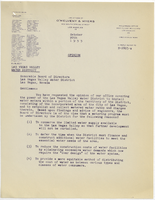Search the Special Collections and Archives Portal
Search Results

Telegram from Edward C. Renwick (Los Angeles) to G. A. Cunningham (Salt Lake City), April 30, 1959
Date
Archival Collection
Description
The Water District advised that they did not have the facilities to supply enough water to Las Vegas and would not object to the Union Pacific Railroad providing water from its shop well.
Text

Telegram from C. C. Larkin (Salt Lake City) to G. A. Cunningham (Salt Lake City), April 30, 1959
Date
Archival Collection
Description
Larkin had discovered that some people and businesses between Las Vegas and Lake Mead were being supplied with water from the railroad shop well. They needed to be advised that they now needed to make arrangements with the water district for their water.
Text

Telegram from G. A. Cunningham (Salt Lake City) to V. W. Smith (Los Angeles), April 24, 1959
Date
Archival Collection
Description
Telegram stating that the railroad should stop selling water to outside businesses and tell their former customers that they needed to get their water from the water district.
Text

Newspaper clipping, Nevada lawmakers study bills to curb operations of agency, Wall Street Journal, March 8, 1957
Date
Archival Collection
Description
The state legislature was holding hearings on a bill that would replace restrictions on the water district that would endanger their outstanding bond issue.
Text

Letter from Thomas A. Campbell (Las Vegas) to members of underwriting group for bonds, including supporting documents, 1957
Date
Archival Collection
Description
Letter from the Las Vegas Valley Water District's president informing the District's bond underwriters that pending legislation had been defeated. The measures would have affected holders of the $8,700,000 waterworks bonds. Supporting documents from the District include a report dated March 30, 1957, which summarized the six pieces of legislation and a press release dated April 1, 1957, outlining the 48th session of the State Legislature's decisions on the legislation.
Text

Contract between the Los Angeles & Salt Lake Railroad, the Union Pacific Railroad, and the Las Vegas Land and Water Company, 1956
Date
Archival Collection
Description
Contract resolving the issue of final payment to the Union Pacific Railroad for contractually obligated work on the water system after the water district had taken control of the water.
Text

Letter from Franklin T. Hamilton (Los Angeles) to Thomas A. Campbell (Las Vegas), October 21, 1955
Date
Archival Collection
Description
Discussion of the courts holding the water district to the Anti-metering law.
Text

Letter including legal opinion from O'Melveny & Myers law offices (Los Angeles) to the Las Vegas Valley Water District Board of Directors, October 20, 1955
Date
Archival Collection
Description
Discussion of laws and court decisions regarding water metering by the Las Vegas Valley Water District.
Text

Letter including Nevada Attorney General Opinion No. 123 from Harvey Dickerson to Thomas A. Campbell (Las Vegas), October 26, 1955
Date
Archival Collection
Description
Notwithstanding Section 6112 of the Public Service Commission Act, the Las Vegas Valley Water District was allowed to meter water to customers; Opinion No. 123.
Text

Press release by Las Vegas Valley Water District on installation of water meters, October 25, 1955
Date
Archival Collection
Description
News release by the Las Vegas Valley Water District reporting that they had formally requested the state attorney general to review and state officially the legality of the District's plans to install water meters in Las Vegas. Statement included opinions from the law firm of O'Melveny & Myers and the District General Counsel Leo A. McNamee. Document has stamp of the Union Pacific Rail Road's law department dated October 26, 1955. Also initials stamp by E. E. Bennett dated October 27, 1955.
Text
